The 1953 Volkswagen Beetle, a symbol of resilience and ingenuity, emerged from the ashes of World War II, captivating the world with its simple design and affordable price. This iconic car, born in a nation rebuilding itself, quickly became a global phenomenon, transforming the automotive landscape and leaving an indelible mark on popular culture.
More than just a vehicle, the Beetle embodied the spirit of post-war optimism, representing a new era of mobility and accessibility. Its compact size and fuel efficiency made it a perfect fit for a world struggling to recover from the devastation of war, while its distinctive design, with its rounded body and iconic “bug” shape, quickly captured the hearts of people worldwide.
Historical Context
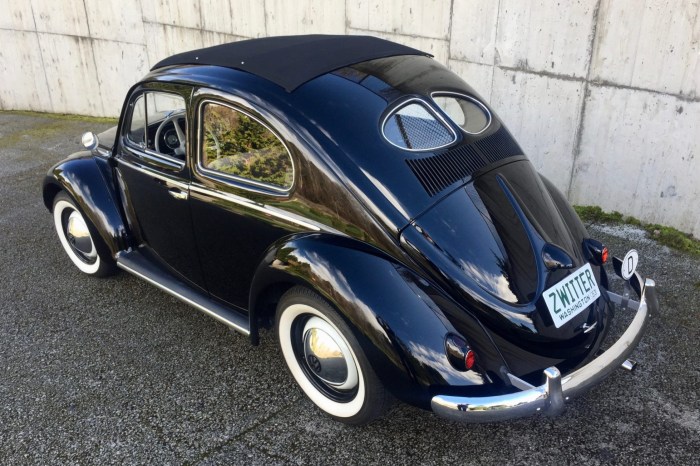
The 1953 Volkswagen Beetle, also known as the Type 1, is more than just a car; it’s a symbol of resilience, innovation, and post-war recovery. This iconic vehicle played a pivotal role in reshaping the German automotive landscape and leaving an enduring legacy on the global stage.The Beetle’s origins can be traced back to the 1930s when Adolf Hitler commissioned Ferdinand Porsche to design a “people’s car” for the masses.
The initial concept, dubbed the “KdF-Wagen” (Kraft durch Freude Wagen, or “Strength Through Joy Car”), aimed to provide affordable transportation for the German population. However, the war disrupted production, and the factory was repurposed for military use.
Design and Engineering Innovations
After World War II, the British military occupied the Volkswagen factory and recognized the potential of the Beetle design. Production resumed in 1945, and the car was rebranded as the Volkswagen, signifying its new purpose as a symbol of German reconstruction.
The 1953 model, while retaining the basic design elements of its predecessor, incorporated several key innovations that contributed to its enduring success.The Beetle’s air-cooled, rear-mounted engine was a revolutionary concept for its time. This design offered several advantages, including:
- Simplified cooling system:The air-cooled engine eliminated the need for a complex water-cooling system, reducing maintenance and increasing reliability.
- Compact and lightweight:The engine’s design allowed for a more compact and lightweight vehicle, enhancing fuel efficiency and maneuverability.
- Durability:The air-cooled engine was less susceptible to damage from extreme temperatures, making it suitable for a wide range of climates.
The Beetle’s unibody construction, where the body and frame are integrated into a single unit, was another innovative feature. This design offered several advantages:
- Increased rigidity:The unibody construction provided a more rigid chassis, enhancing safety and handling.
- Reduced weight:By eliminating the need for a separate frame, the unibody construction reduced the overall weight of the vehicle, further improving fuel efficiency.
- Simplified manufacturing:The unibody design streamlined the manufacturing process, reducing production costs.
The Beetle’s simple and functional design, combined with its innovative engineering, made it a highly affordable and reliable car. This affordability, coupled with its practicality and fuel efficiency, made it a popular choice for families and individuals across the globe.
Impact on Post-War Germany and the Global Automotive Industry
The Beetle’s success was instrumental in reviving the German economy after World War II. The car became a symbol of hope and prosperity, providing affordable transportation for millions of Germans. The factory’s rapid expansion created thousands of jobs, contributing to the country’s economic recovery.The Beetle’s global popularity had a profound impact on the automotive industry.
Its success challenged the dominance of American car manufacturers, demonstrating the potential of smaller, more fuel-efficient vehicles. The Beetle’s influence can be seen in the development of numerous other compact cars, including the Mini Cooper and the Fiat 500.The Beetle’s legacy extends far beyond its impact on the automotive industry.
It became a cultural icon, appearing in films, music, and art. Its distinctive design and enduring popularity have cemented its place as one of the most recognizable and beloved cars in history.
The 1953 Volkswagen Beetle, affectionately nicknamed the “Bug,” was a revolutionary car for its time. It was affordable, reliable, and incredibly fuel-efficient, making it a hit with consumers worldwide. The car’s success continued into the 1960s, with the 1961 Volkswagen Beetle offering even more refined features and design elements.
While the 1953 model is often considered the original icon, the 1961 version cemented the Beetle’s place as a cultural phenomenon and a symbol of affordability and style.
Design and Features
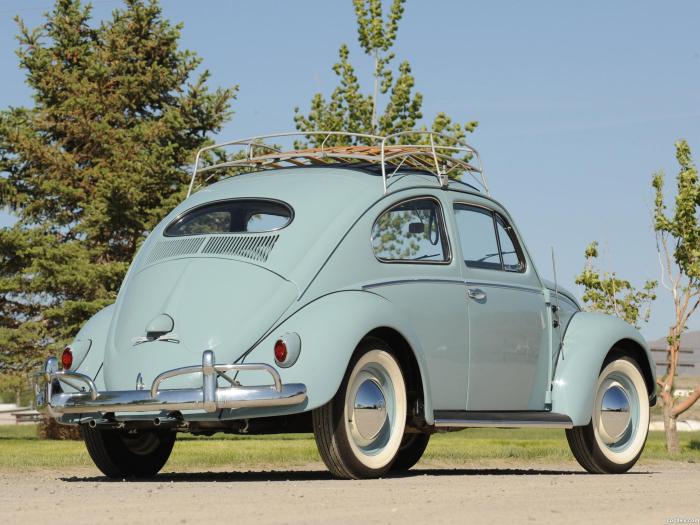
The 1953 Volkswagen Beetle, despite its humble beginnings, showcased a design that was both innovative and functional, setting the stage for a revolutionary automotive era. Its distinctive features, coupled with its robust construction, made it a global icon, a testament to the genius of Ferdinand Porsche.
Design Elements and Distinctive Features
The 1953 Beetle’s design was a product of necessity and ingenuity. The car was designed to be affordable, reliable, and easy to manufacture, all while adhering to the stringent regulations of post-war Germany. This resulted in a vehicle that was both unique and practical.
- Air-cooled engine:The Beetle’s air-cooled engine, located in the rear, was a radical departure from the traditional water-cooled engines of the time. This design not only simplified the engine’s construction but also made it more resistant to damage and easier to maintain.
- Unitary body construction:The Beetle’s body and chassis were a single unit, creating a rigid and robust structure. This design, also known as a “unibody,” contributed to the car’s safety and durability.
- Independent suspension:The Beetle’s independent suspension system, which allowed each wheel to move independently, provided a smooth and comfortable ride. This feature was particularly impressive for a car in its price range.
- Distinctive shape:The Beetle’s rounded shape, with its distinctive “bug-eye” headlights and rounded fenders, became an instantly recognizable design element. This aerodynamic shape contributed to the car’s fuel efficiency and overall performance.
Comparison to Earlier Volkswagen Models
The 1953 Beetle was the first iteration of the iconic model, building upon the success of the earlier Volkswagen KdF-Wagen, which was initially designed for the German people’s car project. The KdF-Wagen was a simpler, less refined vehicle, with a more utilitarian design.
The Beetle, however, incorporated several improvements, including a more powerful engine, a more comfortable interior, and a more refined exterior design.
Interior Features
The Beetle’s interior, though spartan, was functional and well-designed. It prioritized practicality and comfort over luxury.
- Simple dashboard:The dashboard was uncluttered, with basic gauges and controls. This design focused on functionality and ease of use.
- Vinyl upholstery:The seats were upholstered in durable vinyl, which was easy to clean and maintain.
- Limited interior space:The Beetle’s interior was compact, with limited legroom and headroom, reflecting its design focus on affordability and efficiency.
Exterior Features
The Beetle’s exterior design, with its distinctive shape and features, made it a truly unique car.
- Rounded body:The Beetle’s rounded body shape was both aerodynamic and visually appealing.
- “Bug-eye” headlights:The Beetle’s distinctive headlights, positioned above the front fenders, gave the car its iconic “bug-eye” look.
- Simple grille:The Beetle’s grille was simple and functional, with a chrome trim that added a touch of elegance.
- Rear-mounted engine:The Beetle’s engine was located in the rear, which gave the car a distinctive rear-heavy stance.
Production and Sales: 1953 Volkswagen Beetle
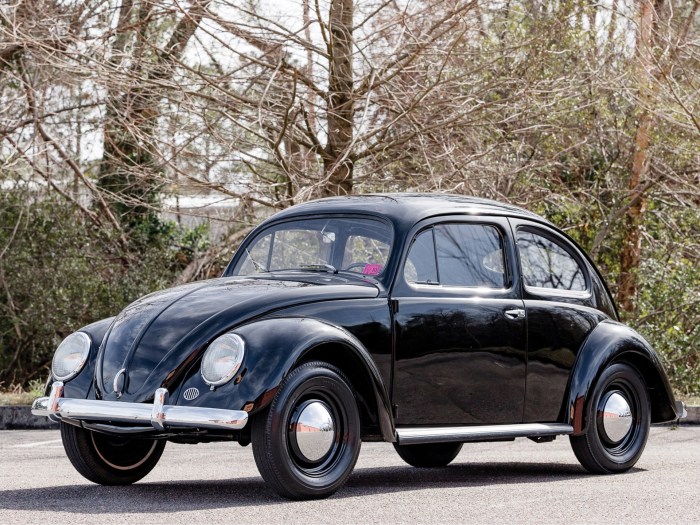
The 1953 Volkswagen Beetle, a symbol of postwar Germany’s economic recovery and a testament to its engineering prowess, was produced in staggering numbers, quickly becoming a global phenomenon. Its production process, a blend of efficiency and meticulous craftsmanship, was instrumental in its success.
Production Process
The production process of the 1953 Beetle was characterized by its efficiency and precision. The factory in Wolfsburg, Germany, employed a highly streamlined assembly line, where each worker was responsible for a specific task. This division of labor ensured that the production process was both rapid and consistent.
The factory’s motto was “Jeder kann es” (“Anyone can do it”), emphasizing the ease of assembly and the company’s belief in the skill of its workforce.
The Beetle’s design, with its simple and modular components, further facilitated efficient production. Parts were standardized, allowing for interchangeability and minimizing the need for specialized tools. This approach ensured that the production process could be scaled up quickly to meet growing demand.
Sales Figures and Market Penetration
The 1953 Beetle enjoyed phenomenal sales success, becoming one of the best-selling cars in history.
The 1953 Volkswagen Beetle was a symbol of postwar Germany, a car that was affordable, reliable, and surprisingly fun to drive. While the Beetle was known for its practicality, Volkswagen wanted to explore a sportier side, which led to the creation of the 1957 Volkswagen Karmann Ghia.
This stylish coupe, designed by Italian coachbuilder Carrozzeria Ghia, gave Volkswagen a foothold in the burgeoning sports car market. But it was the Beetle, with its iconic shape and unwavering reliability, that truly cemented Volkswagen’s place in automotive history.
- In 1953, Volkswagen produced approximately 100,000 Beetles, a significant increase from the previous year’s production.
- By the end of the decade, the Beetle had become a global phenomenon, with sales exceeding 1 million units annually.
The Beetle’s market penetration was remarkable, particularly in the United States, where it captured a significant share of the small car market. Its affordability, reliability, and unique design appealed to a wide range of consumers.
Factors Contributing to Success, 1953 Volkswagen Beetle
Several factors contributed to the phenomenal success of the 1953 Beetle.
The 1953 Volkswagen Beetle, a symbol of post-war German ingenuity, was a far cry from the sporty, performance-oriented vehicles that were gaining popularity in the 1970s. The introduction of the 1980 Volkswagen GTI marked a turning point for the brand, showcasing Volkswagen’s ability to blend practicality with performance.
While the Beetle remained a beloved icon, the GTI paved the way for a new generation of Volkswagen enthusiasts who sought a more dynamic driving experience.
- Affordability:The Beetle’s simple design and efficient production process made it remarkably affordable, particularly compared to other cars available at the time.
- Reliability:The Beetle’s robust construction and simple mechanical design made it extremely reliable, requiring minimal maintenance and repairs. This was a significant selling point in an era when car reliability was often a concern.
- Fuel Efficiency:The Beetle’s small engine and aerodynamic design made it remarkably fuel-efficient, a critical factor in the post-war period when fuel prices were high.
- Marketing and Branding:Volkswagen’s marketing strategy was innovative and effective, emphasizing the Beetle’s practicality, affordability, and unique design. The car’s distinctive shape and “people’s car” image resonated with consumers worldwide.
- Post-War Demand:The Beetle emerged at a time when there was a significant demand for affordable and reliable transportation, particularly in Europe, where the war had destroyed much of the existing infrastructure.
The 1953 Volkswagen Beetle’s success was a testament to its engineering prowess, its innovative production process, and its ability to meet the needs of a changing world.
Cultural Impact
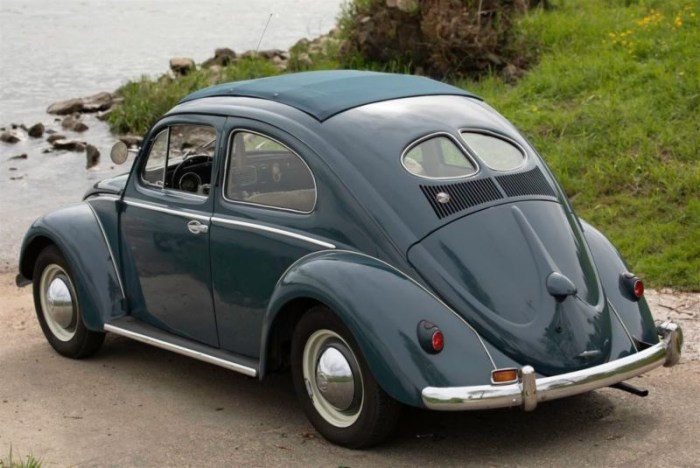
The 1953 Volkswagen Beetle transcended its status as a mere automobile, becoming a cultural icon that resonated with people across the globe. Its simple design, affordability, and reliability made it a symbol of post-war optimism and a vehicle that embodied the spirit of a generation.
The Beetle in Popular Culture
The Beetle’s cultural impact is evident in its frequent appearances in popular culture. Its distinctive shape and character made it a popular choice for filmmakers, musicians, and artists.
- In cinema, the Beetle featured prominently in films like “Herbie the Love Bug,” a series of comedies starring a sentient Beetle that captured the hearts of audiences worldwide.
- Music icons like the Beatles and the Beach Boys incorporated the Beetle into their music videos and album covers, reflecting the car’s association with youth culture and the burgeoning rock and roll scene.
- Artists and graphic designers often used the Beetle as a motif in their works, highlighting its simplicity and iconic status.
The Beetle’s Lasting Impact on Automotive Design
The Beetle’s influence on automotive design is undeniable. Its aerodynamic shape, rear-engine layout, and emphasis on functionality set a precedent for future car designs.
“The Beetle’s simple design and efficient use of space inspired generations of car designers to prioritize functionality over ornamentation.”
Neil Patel
- The Beetle’s compact size and maneuverability influenced the development of small cars, such as the Mini Cooper and the Fiat 500, which became popular in urban environments.
- Its air-cooled engine technology, though later replaced by water-cooled engines, paved the way for innovative engine designs in the automotive industry.
- The Beetle’s iconic status inspired manufacturers to create “retro” designs that paid homage to the original, further cementing its legacy in automotive design.
End of Discussion
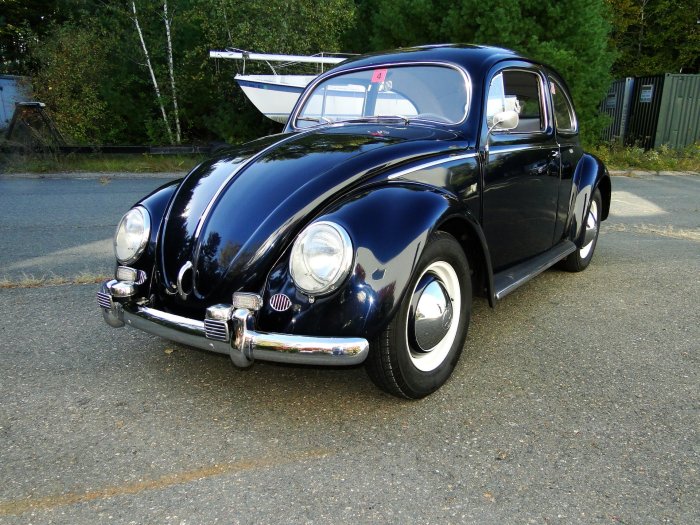
The 1953 Volkswagen Beetle’s legacy extends far beyond its initial success. It revolutionized automotive design, proving that simplicity and affordability could be a winning formula. Its enduring popularity, spanning decades and generations, solidified its place as a cultural icon, a testament to its timeless appeal and the ingenuity of its creators.
The Beetle’s story is a reminder that even in the face of adversity, innovation and ingenuity can lead to remarkable achievements, leaving a lasting impact on the world.